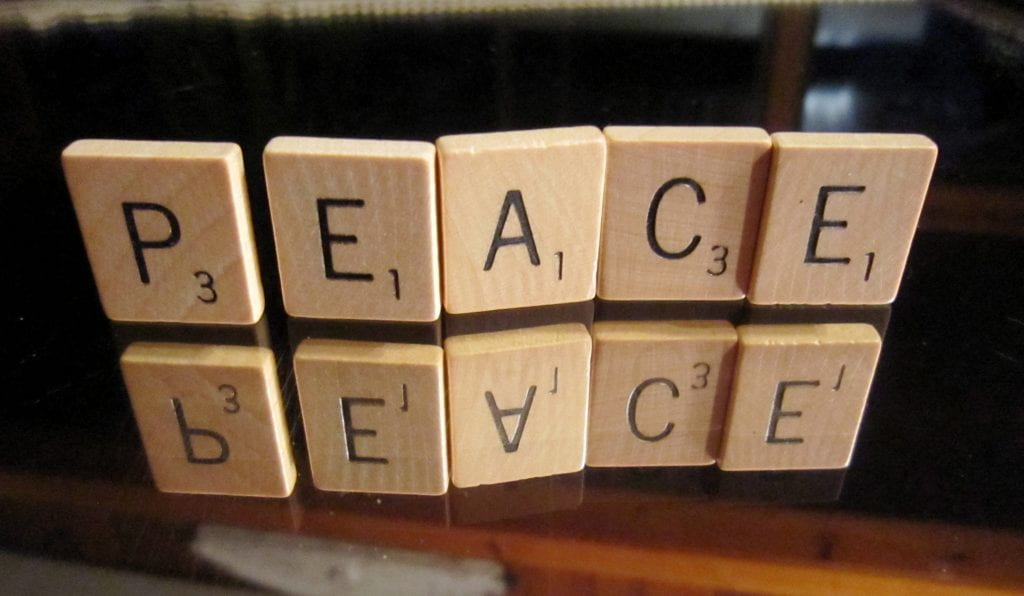
After being a participant in many classes in Peace and Peace Studies, I have had the opportunity to reorient my beliefs about the role of war and violence in humanity. Contrary to the Hobbesian view that humans are born to be violent, their birth is violent after all, and people resort to violence naturally to maintain their social, political, and religious power and positions, I find that this is not necessarily the absolute truth. Several “truisms” are now more apparent to me: (1) that while conflict is unavoidable among living beings (humans and primates), the resolution of the conflicts can take various forms including nonviolent practices; (2) peaceful resolutions can be taught through socialization and education; and (3) war did not exist prior to 10,000 years ago. These are broad, I know, but they underline my revised thinking about the state of our world today and the messages that are conveyed by the media, education systems, politicians, etc.
In an article on aggression in children, it was shown that children can be taught to be cooperative or aggressive and that their responses to frustrating situations will be contingent on their training. Those children who were taught and encouraged to be aggressive, responded with aggressive behaviors when denied their movie and ice cream. And those who were trained and encouraged to be cooperative, actually became more cooperative when faced with the same frustrations. The article ended with “can peace be taught?”. I think this is definitely so as we have studied different peaceful societies where conflict resolution techniques include: avoidance, withdrawal, mock conflicts (where no permanent harm is done), apologies, community mediation gatherings, etc. In addition, there is research that shows that the majority of soldiers in previous wars did not pull their triggers and that soldiers have had to be trained, coerced, and shamed into going into battle to kill another human being. As we are facing a daily crisis of suicides committed by veterans, we know that by putting men and women in aggressive, warlike situations permanently scars them not only physically, but even more so emotionally. If violence was innate, we would not be having so many emotionally wounded returning soldiers who struggle to enter and maintain daily life and their relationships.
If we look at the research from Chenoweth & Stephan’s Why Civil Resistance Works, we find they demonstrate that not only do nonviolent campaigns have a greater success rate and are increasing in frequency since 1900, they tend to attract many more participants from all ages, social sectors, and economic classes. Whereas, violent movements typically attract young males and may be related to their need for social recognition along with promised economic and status rewards. Another aspect to consider when looking at the violent versus nonviolent nature of humankind (or creature-kind!) is that in nonviolent movements there are loyalty shifts that occur within the security sector. Men and women who are hired to be violent towards another have been shown to lay down their weapons or just stand there rather than exercising violence on another who really is just like them or a family member. I think about the nonviolent campaigns where resistors presented soldiers and police with roses to put in their guns, told them they were loved and were embraced as being one of them and not the enemy. Popovic talks about the use of toys to demonstrate the sentiments of the people under oppressive regimes, to present some levity, but also show the nonviolent tactics in a civil resistance movement. Even the use of language can reinforce nonviolence in the words and expressions selected. Instead of “Death to the Shah”, one can pick a slogan that is positive and nonviolent – “We want peace now”. All of these remind each of us, and the communities we belong to, that it is our responsibility to make choices about whether to be nonviolent and peaceful or violent in our lives, actions and words. I do think that it is a choice that may take re-education and intentionality.
As I type this, there was news notification about a senator who was raped while she was in the military and how she felt raped also by the system. I think we have used the excuse that men are just men and they are innately violent to give them passes for the actions they take instead of condemning their actions and reinforcing that we all are peaceful until we learn to be aggressive with others and sometimes with ourselves. Peaceful interactions and actions can be taught and socialized and reinforced within any society!
